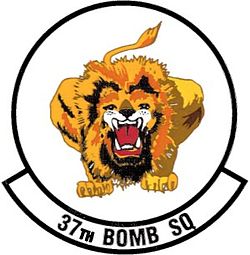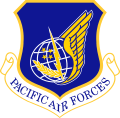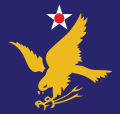37th Bomb Squadron  | |
|---|---|
 | |
| Active | 1917–1919; 1933–1938; 1940–1945; 1947–1948; 1952–1958; 1977–1982; 1987–present |
| Country | |
| Branch | |
| Role | Heavy bomber |
| Part of | Global Strike Command |
| Garrison/HQ | Ellsworth Air Force Base |
| Nickname | Tigers [1] |
| Motto | “Harrumph!” [2] |
| Mascot | Billy the tiger[ citation needed ] |
| Engagements | American Theater (World War II) Mediterranean Theater of Operations European Theater of Operations Korean War [3] Operation Desert Fox Operation Allied Force Operation Enduring Freedom Operation Iraqi Freedom Operation Odyssey Dawn Operation Freedom's Sentinel Operation Inherent Resolve |
| Decorations | Distinguished Unit Citation Air Force Meritorious Unit Award Air Force Outstanding Unit Award with "V" Device French Croix de Guerre with Palm Republic of Korea Presidential Unit Citation |
| Insignia | |
| 37th Bombardment Squadron emblem [b] [3] |  |
| 37th Bomb Squadron emblem [c] [4] |  |
| 37th Pursuit Squadron emblem [d] [4] [5] |  |
The 37th Bomb Squadron is part of the 28th Bomb Wing at Ellsworth Air Force Base, South Dakota. It operates Rockwell B-1 Lancer aircraft providing strategic bombing capability.
Contents
- History
- World War I
- Inter-war years
- World War II
- Korean War
- Tactical jet bomber operations
- Strategic bombardment operations
- Lineage
- Assignments
- Stations
- Aircraft
- See also
- Explanatory notes
- References
- Citations
- Bibliography
- External links
The squadron is one of the oldest in the United States Air Force, its origins dating to 13 June 1917, when the 37th Aero Squadron was organized at Kelly Field, Texas. The squadron deployed to France as part of the American Expeditionary Force during World War I and served as a training unit until returning to the US for demobilization. It was active in the interwar years at Langley Field, Virginia as a pursuit and attack squadron.
The squadron saw combat as the 37th Bombardment Squadron, a Martin B-26 Marauder unit in the Mediterranean Theater of Operations during World War II, earning two Distinguished Unit Citations (DUC) for its performance. It was inactivated after the war's end, although it was briefly active as a paper unit in 1947–1948.
The squadron was again activated during the Korean War, when it replaced a reserve unit that was being returned to reserve duty. Flying night intruder missions with Douglas B-26 Invaders, the squadron earned another DUC before the truce in July 1953. In 1955 it returned to the United States and became one of the first jet tactical bomber units, flying Martin B-57 Canberras and Douglas B-66 Destroyers. After a brief deployment to England, the squadron once again inactivated.
In 1977, the 37th became part of the Strategic Air Command, flying Boeing B-52 Stratofortresses until 1982. It assumed its present role in 1987.
The squadron is an honorary member of the NATO Tiger Association [ citation needed ]
















